SU-100
The SU-100 (Samokhodnaya Ustanovka 100) was a Soviet tank destroyer armed with a 100 mm anti-tank gun in a casemate superstructure. It was used extensively during the last year of World War II and saw service for many years afterwards with the armies of Soviet allies around the world.[1]
| SU-100 | |
|---|---|
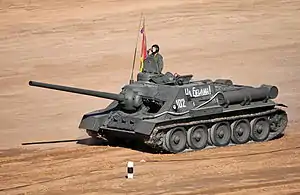 Russian SU-100 at a 2013 tank biathlon. | |
| Type | Tank destroyer |
| Place of origin | Soviet Union |
| Production history | |
| No. built | 2,335+ |
| Specifications | |
| Mass | 31.6 tonnes (69,665 lbs) |
| Length | 9.45 m (30 ft) |
| Width | 3.00 m (9 ft 10 in) |
| Height | 2.25 m (7 ft 5 in) |
| Crew | 4 |
| Armor | front: 75 mm (3 in) sides: 45 mm (1.77 in) rear: 45 mm (1.77 in) roof: 20 mm (.78 in) |
Main armament | 100 mm D-10S gun |
| Engine | Kharkiv Model V-2 V-12 diesel engine 500 hp (370 kW) |
| Power/weight | 15.8 hp/tonne |
| Suspension | Christie |
Operational range | 200–250 km (199 mi) |
| Maximum speed | 48 km/h (30 mph) |
Development
The SU-85 was developed from the chassis of the T-34 tank replacing the turret with a larger, fixed superstructure that allowed a larger gun to be fitted: the 85 mm D-5 gun, providing dramatically upgraded firepower compared to the T-34's 76.2 mm models. Introduced to service in 1943, the SU-85 was quickly rendered obsolete as a new tank design featured the same gun on the T-34-85.[1]
This prompted the design of a more advanced turretless tank destroyer with an even more powerful cannon. Development was conducted under supervision of L. I. Gorlitskiy, chief designer of all medium Soviet self-propelled guns. The work started in February 1944 and the first prototype of the SU-100, "Object 138", was delivered in March. After intensive testing with different models of 100 mm gun Soviet engineers approved the D-10S gun for mass production.[1] This gun was developed in Constructors Bureau of Artillery Factory No. 9 under the guidance of F. F. Petrov. After the Second World War this gun was installed on T-54 and T-55 tanks; these vehicles and their derivatives were in service forty years after initial development.
It was built at the UZTM (Russian abbreviature УЗТМ for Уральский Завод Тяжелого Машиностроения – Ural Heavy Machinery Factory, also called Uralmash) in Yekaterinburg. The SU-100 quickly proved itself to be able to penetrate around 125 mm (4.9 in) of vertical armor from a range of 2,000 m (1.2 mi) and the sloped 80 mm (3.1 in) front armor of the German Panther from 1,500 m (0.93 mi).[1]
The hull of the SU-100 had major improvements over the SU-85; the thickness of the front armour was increased from 45 to 75 mm (1.8 to 3.0 in), and the commander's workplace was made in a small sponson on the right side of the hull; combined with the commander's cupola this improved the commander's effectiveness. Its German Jagdpanzer-family counterparts — the Jagdpanzer IV, Jagdpanther and Jagdtiger, by comparison, lacked this key piece of observational equipment. On the other hand, the SU-100's optics were inferior. For better ventilation two ventilator units were installed, instead of only one as in the SU-85. Mass production began in September 1944.
Service history
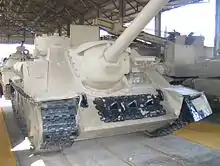
The SU-100 saw extensive service during the last year of the war. It was used en masse in Hungary in March 1945, when Soviet forces defeated the German Operation Frühlingserwachen offensive at Lake Balaton.[1] By July 1945, 2,335 SU-100s had been built.
The vehicle remained in service with the Red Army well after the war; production continued in the Soviet Union until 1947 and into the 1950s in Czechoslovakia. It was withdrawn from Soviet service in 1967 but many vehicles were transferred to reserve stocks. Some exist to this day in the Russian Army holding facilities.
Many Warsaw Pact countries also used the SU-100, as did Soviet allies such as Egypt, Angola and Cuba. A few SU-100 were delivered to Yugoslavia after the war, under the designation M-44.[2] The SU-100 saw service in the fighting that accompanied the 1956 Suez Crisis, in which the Egyptians used SU-100s against Israel's M4 Sherman tanks. The vehicle was also utilized in the 1967 Six-Day War and the 1973 Yom Kippur War. It was modified slightly to adapt it to the sandy conditions of the Middle East, thus creating the SU-100M variant . Exported SU-100s continued in service until the 1970s, and in some countries, even later. Yugoslavs used them during the civil war; however, due to lack of spare parts they were quickly retired, despite their satisfactory performance. The SU-100 remains in use by the Vietnam People's Army and the Korean People's Army Ground Force.
SU-100s entered service with the People's Liberation Army (PLA) of China after 1 December 1950 when Soviet forces left Dalian. The armaments in Dalian were sold to China, including 99 SU-100s, 18 IS-2 heavy tanks, and 224 T-34s, with which PLA formed its 1st Mechanised Division.
In April 2015, a SU-100 self-propelled gun was photographed being used in Yemen as part of the ongoing conflict.[3] Video evidence uploaded to YouTube in November 2016 showed an apparent SU-100 being knocked out by an anti-tank guided missile in Yemen.[4]
Operators
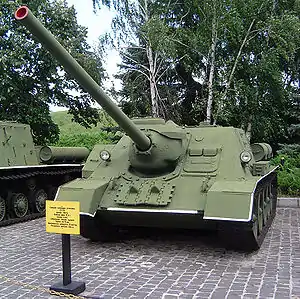
 Algeria: 50 in reserve.[5][6]
Algeria: 50 in reserve.[5][6]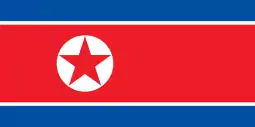 North Korea: 100[7]
North Korea: 100[7] Morocco: 25;[7] 8 operational.[5]
Morocco: 25;[7] 8 operational.[5] Romania: 47 in reserve as of 2016.[8]
Romania: 47 in reserve as of 2016.[8]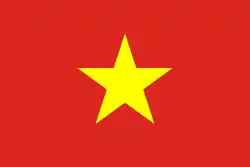 Vietnam: 100[7]
Vietnam: 100[7] Yemen: 70[5]
Yemen: 70[5]
Former operators
 Albania: Retired[9]
Albania: Retired[9] Angola: 40;[7] all destroyed in the Angolan Civil War or decommissioned by the late 1980s.[10]
Angola: 40;[7] all destroyed in the Angolan Civil War or decommissioned by the late 1980s.[10]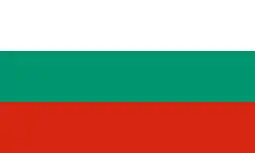 Bulgaria: 100[7]
Bulgaria: 100[7] People's Republic of China: 300[7]
People's Republic of China: 300[7] Cuba: 100[7]
Cuba: 100[7] Czechoslovakia: 200[7]
Czechoslovakia: 200[7]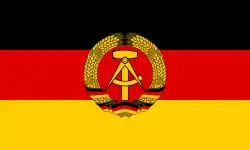 East Germany: 50[7]
East Germany: 50[7] Egypt: 150[7]
Egypt: 150[7] Hungary: 50[7]
Hungary: 50[7] Iraq: 250[7]
Iraq: 250[7].svg.png.webp) Mongolia: 10[7]
Mongolia: 10[7] North Yemen: 50[7]
North Yemen: 50[7] Poland: 25 or 26. Withdrawn from service in late 1960s.[11]
Poland: 25 or 26. Withdrawn from service in late 1960s.[11] Soviet Union[12]
Soviet Union[12] Syria: 80[7]
Syria: 80[7].svg.png.webp) Yugoslavia: 40[13]
Yugoslavia: 40[13]
See also
Tanks of comparable role, performance and era
References
- Higgins, David R. (2014). Jagdpanther vs SU-100. Eastern Front 1945. Osprey Publishing.
- Lovac tenkova SU-100 Archived 2 February 2012 at the Wayback Machine. Members.multimania.co.uk. Retrieved on 2012-04-14.
- http://www.uskowioniran.com/2015/04/wwii-era-soviet-armor-engaged-in-yemen.html "WWII era Soviet armor engaged in Yemen conflict"
- "YouTube". www.youtube.com. Retrieved 19 April 2018.
- Cordesman, Anthony (October 2016). After The Storm: The Changing Military Balance in the Middle East. London: Bloomsbury Publishing. pp. 112–124, 701. ISBN 978-1-4742-9256-6.
- Nerguizian, Aram; Cordesman, Anthony (2009). The North African Military Balance: Force Developments in the Maghreb. Washington DC: Center for Strategic and International Studies Press. pp. 44–46. ISBN 978-089206-552-3.
- "Trade Registers". Armstrade.sipri.org. Retrieved 20 June 2013.
- "United Nations Register of Conventional Arms: Report of the Secretary-General" (PDF). New York: United Nations. 14 July 2016. Archived from the original (PDF) on 4 October 2016. Retrieved 4 October 2016.
- М. Барятинский. (2017). Самоходные установки на базе Т-34. Litres. p. 29. ISBN 978-5-699-23790-6.
- (PDF). 16 June 2017 https://web.archive.org/web/20170616201822/http://www.veteranangola.ru/upload/1291487849_FILE.pdf. Archived from the original on 16 June 2017. Retrieved 19 April 2018. Missing or empty
|title=(help)CS1 maint: bot: original URL status unknown (link) - Jurek. "SU-100, średnie działo pancerne". www.2wojna.pl. Retrieved 19 April 2018.
- "Soviet Ground Force Weapons And Armored Vehicles" (PDF). Langley: Central Intelligence Agency. August 1969. Archived from the original (PDF) on 10 March 2017. Retrieved 20 May 2017.
- Kočevar, Iztok (August 2014). "Micmac à tire-larigot chez Tito: L'arme blindée yougoslave durant la Guerre froide" [The Yugoslav armored arm during the Cold War]. Batailles et Blindés (in French). No. 62. Caraktère. pp. 66–79. ISSN 1765-0828.
External links
| Wikimedia Commons has media related to SU-100. |
- The SU-100 Tank Destroyer at Battlefield.ru
- SU-100 at WWIIvehicles.com
- SU-100 data at OnWar.com
